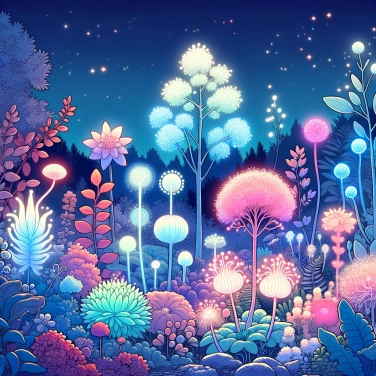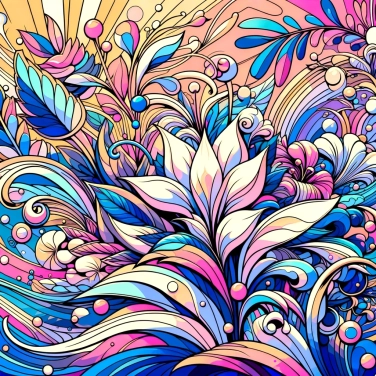Some plant species are phosphorescent at night thanks to a chemical reaction called bioluminescence, produced by microorganisms present in their tissues.

Plant bioluminescence is a natural phenomenon where certain plants emit visible light at night. The source of this astonishing property is usually a molecule called luciferin, which reacts with a special enzyme, luciferase. When these two substances come into contact in the presence of oxygen, they trigger a chemical reaction that produces cold light, without heat. This mechanism occurs directly in plant cells, often in response to specific environmental conditions. This phenomenon is considered rare in plants, but truly fascinating to observe.
Bioluminescent plants use their light to attract certain pollinating insects during the night. By emitting a glow visible in the darkness, they increase their visibility and enhance their chances of successful reproduction. It's a bit like these plants are doing their own light advertisement to signal to insects: "Hey, over here for some nectar!"
In some cases, luminescence can also deter nocturnal herbivores. Emitting an unusual light could signal to animals: "Warning, toxic or indigestible plant!" Thus, light emission means less damage and better survival.
Finally, phosphorescence sometimes serves to attract the natural predators of threatening herbivores for the plant. In short, these plants are making allies by simply turning on their little bio lamp. Not a bad strategy for surviving peacefully in the night.
The Mycena chlorophos mushroom primarily grows in Southeast Asia and Oceania, where it illuminates the forest with an astonishing greenish light at night. Super easy to spot in the dark.
Some trees, such as those of the Neonothopanus genus, particularly Neonothopanus gardneri, emit a greenish phosphorescence from their bark. This phenomenon, easily observable especially in Brazil, attracts the attention of nocturnal insects.
The Schistostega pennata moss, nicknamed "goblin gold," has cells that reflect a mystical yellow-green light when it grows in the shade of dark, damp rock cavities. Super pretty.
Another impressive species is the Panellus stipticus mushroom, which is mainly found in North America and Europe. Highly appreciated by fans of "glowing" mushrooms, its bluish luminescence fascinates night observers.
In Russia and Japan, the species Armillaria mellea, or honey-colored armillaria, produces a faint greenish light on dead or sick wood. This mushroom is also known as "honey mushroom" (but be careful, it’s not edible raw!).
Ambient temperature directly influences light intensity: mild temperatures promote optimal enzymatic activity, thereby increasing the nocturnal phosphorescence of plants. Similarly, a good level of humidity encourages bioluminescence, as it aids the chemical reactions involved. The degree of darkness at night also matters, as luminescence is more likely to be perceptible in total dimness. Surrounding stress, such as herbivore attacks or certain injuries, can also enhance these luminous effects, serving as a warning or defense signal. Finally, certain components of the soil, particularly essential nutrients like phosphorus or nitrogen, can indirectly influence this phosphorescent capacity by affecting the overall health of the plants.
When plants become luminous, it can transform their entire ecosystem: for example, attracting nocturnal pollinators or repelling certain herbivores sensitive to this unusual light. As a result, unprecedented ecological interactions emerge in the environment where these luminous plants grow. This biological innovation can lead to a rapid diversification of species coexisting with these plants, as they all must adapt to this new situation. Consequently, plant luminescence acts as a driver for greater ecological diversity, stimulating the emergence of new evolutionary traits in surrounding insects and animals. It's a bit like turning on a lamp in the middle of the night and seeing everyone react differently.
Researchers are studying how to introduce the genes responsible for luciferase, a key protein in plant bioluminescence, into urban trees to provide soft and environmentally friendly lighting. This concept, called 'lamp trees', could revolutionize green spaces in urban areas.
The phosphorescence of certain mushrooms and plants helps attract nocturnal animals. These animals facilitate the dispersal of spores or seeds, thus playing a crucial role in the reproduction and survival of these luminous plant species.
The natural phenomenon of plant phosphorescence (or bioluminescence) has inspired many legends and popular myths in different cultures around the world, including stories of enchanted forests and magical plants that glow in the moonlight.
Some phosphorescent plants were historically used by indigenous populations as a means of natural lighting. The glowing leaves or mosses were used to mark paths or subtly illuminate dwellings in the darkness.
Yes, light pollution can significantly influence the bioluminescent behavior of many plant species. Excessively intense artificial lighting can disrupt natural light emission, reducing or altering its effectiveness and disturbing the associated animal and plant species.
Some notable examples include mushrooms such as Armillaria and Mycena chlorophos. Among more traditional plants, research is underway to commercially develop bioluminescent plants derived from experiments conducted on species such as Arabidopsis thaliana or genetically modified tobacco.
No, while most phosphorescent plants use a biological process involving enzymes called luciferases and light-emitting compounds called luciferins, the exact mechanisms may vary slightly between species. Each plant has adapted this process according to its own ecological constraints.
Although the two terms are sometimes used interchangeably, they refer to two different phenomena. Bioluminescence is the emission of light through a natural chemical reaction in a living organism, while phosphorescence is the emission of light due to the prior absorption of light, which is gradually released in the dark. Plants often described as phosphorescent at night are actually bioluminescent.
As of today, there is no scientific evidence indicating a negative effect related to plant bioluminescence on health or the ecosystem. On the contrary, this natural phenomenon generally has a beneficial ecological role, attracting pollinators or protecting plants from certain herbivores.
Some companies and laboratories are currently working to make bioluminescent plants available to the general public for decorative purposes. However, these genetically modified plants are still often limited to controlled environments or regulated by environmental authorities.

No one has answered this quiz yet, be the first!' :-)
Question 1/5